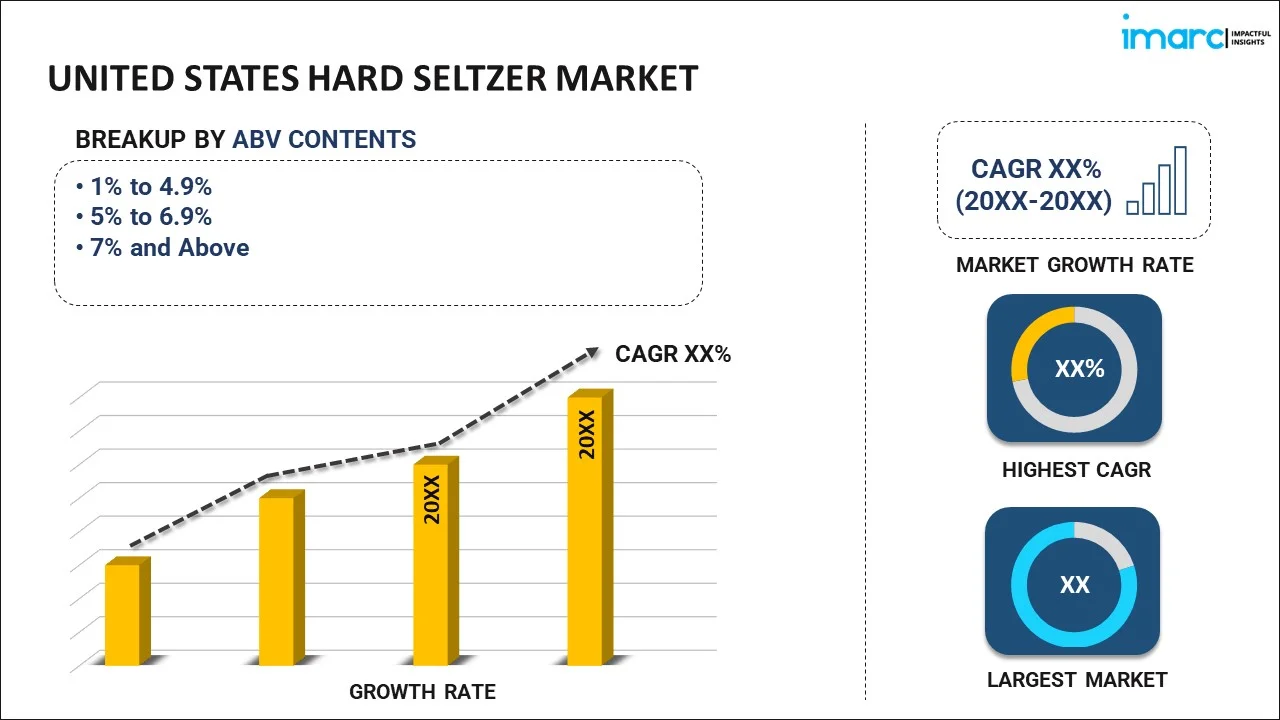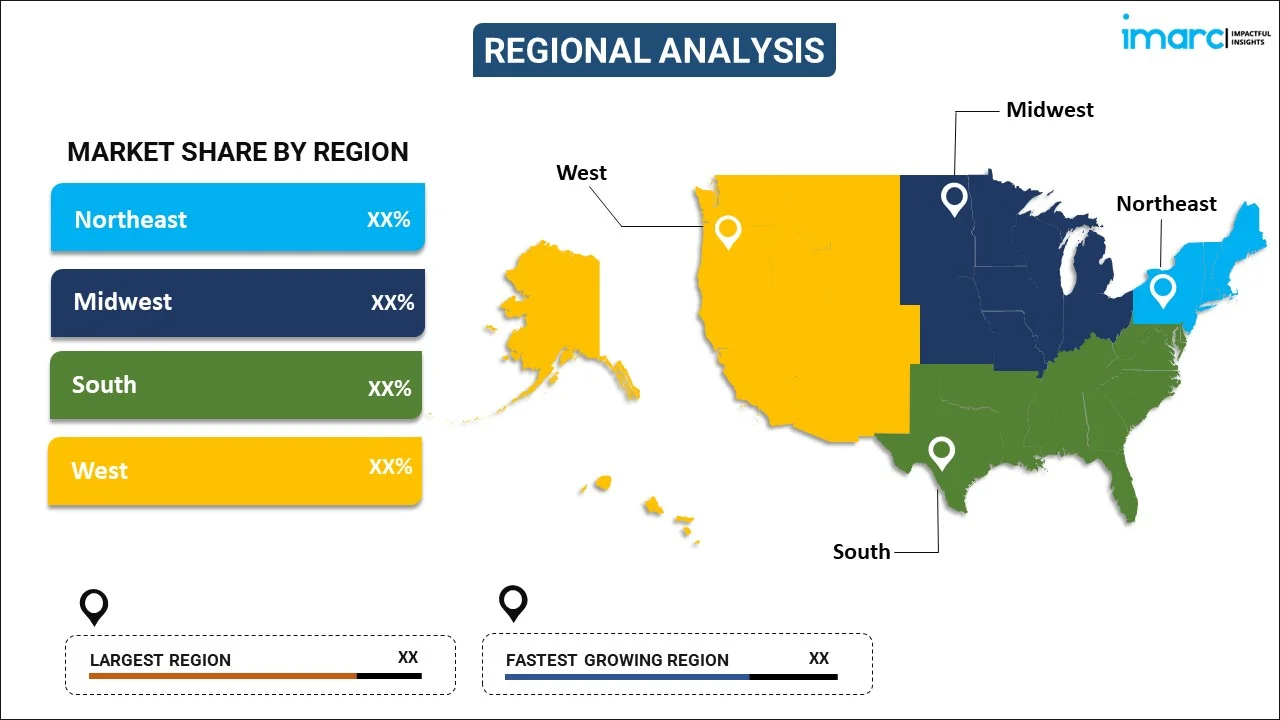
United States Hard Seltzer Market Report by ABV Content (1% to 4.9%, 5% to 6.9%, 7% and Above), Packaging Material (Cans, Glass, and Others), Distribution Channel (Supermarkets and Hypermarkets, Online Stores, and Others), Flavor (Cherry, Grapefruit, Mango, Lime, and Others), and Region 2025-2033
Market Overview:
United States hard seltzer market size reached USD 1,960.6 Million in 2024. Looking forward, IMARC Group expects the market to reach USD 5,350.2 Million by 2033, exhibiting a growth rate (CAGR) of 11.8% during 2025-2033. The shifting consumer preference towards healthier beverage choices, the convenience of ready-to-drink (RTD) options, the escalating demand for variety and flavors, the impact of the COVID-19 pandemic on at-home consumption, strong brand presence and marketing efforts, and the influence of social media are facilitating the market growth.
|
Report Attribute
|
Key Statistics
|
|---|---|
|
Base Year
|
2024 |
|
Forecast Years
|
2025-2033
|
|
Historical Years
|
2019-2024
|
| Market Size in 2024 | USD 1,960.6 Million |
| Market Forecast in 2033 | USD 5,350.2 Million |
| Market Growth Rate (2025-2033) | 11.8% |
Hard seltzer is a popular alcoholic beverage that has gained significant traction in recent years, especially among consumers seeking a light and refreshing alternative to traditional alcoholic drinks. It involves a relatively straightforward process, starting with the creation of a base alcohol, often derived from fermented sugar, grains, or malt. This base alcohol serves as a neutral canvas onto which flavors and carbonation are added, resulting in a clean and crisp taste profile. Hard seltzer is a versatile beverage with a variety of uses, such as it is primarily consumed as a refreshing alcoholic drink, often favored for its lightness and low-calorie content. Many people choose hard seltzer as an alternative to beer or mixed cocktails, especially in social settings where a lighter option is preferred. Its neutral taste allows for a wide range of flavor profiles to be incorporated, appealing to a broad audience. The advantages of hard seltzer include its low calorie and sugar content, making it a more health-conscious option compared to some other alcoholic beverages. It has gained popularity as a choice for those looking to enjoy a drink without excessive guilt about their calorie intake. There are various types of hard seltzer available on the market, from fruity to natural, using real or artificial ingredients. Some include botanicals and differ in sweetness, from dry to moderately sweet.
United States Hard Seltzer Market Trends:
The United States hard seltzer market is influenced by several key drivers, such as the shift towards healthier beverage choices, which has led consumers to opt for lower-calorie and lower-sugar alternatives, making hard seltzers an appealing option. In line with this, the increasing focus on health and wellness, along with the desire for variety, has contributed to the surge in flavored hard seltzers, which is fueling the market growth. Furthermore, the COVID-19 pandemic accelerated the trend of at-home consumption, boosting sales of hard seltzers as they became a popular choice for home entertainment, which is stimulating the market growth. In line with this, the presence of well-established brands in the market, along with their extensive marketing efforts, has played a significant role in driving consumer awareness and adoption, further accelerating the market growth. Moreover, the availability of gluten-free and vegan options has also widened the consumer base, which is boosting the market growth. Apart from this, the competitive pricing of hard seltzers relative to traditional alcoholic beverages has made them an attractive choice for cost-conscious consumers, which is favoring the market growth in the country.
United States Hard Seltzer Market Segmentation:
IMARC Group provides an analysis of the key trends in each segment of the market, along with forecasts at the country level for 2025-2033. Our report has categorized the market based on ABV content, packaging material, distribution channel, and flavor.
ABV Content Insights:

- 1% to 4.9%
- 5% to 6.9%
- 7% and Above
The report has provided a detailed breakup and analysis of the market based on the ABV content. This includes 1% to 4.9%, 5% to 6.9%, and 7% and above.
Packaging Material Insights:
- Cans
- Glass
- Others
A detailed breakup and analysis of the market based on the packaging material have also been provided in the report. This includes cans, glass, and others.
Distribution Channel Insights:
- Supermarkets and Hypermarkets
- Online Stores
- Others
The report has provided a detailed breakup and analysis of the market based on the distribution channel. This includes supermarkets and hypermarkets, online stores, and others.
Flavor Insights:
- Cherry
- Grapefruit
- Mango
- Lime
- Others
A detailed breakup and analysis of the market based on the flavor have also been provided in the report. This includes cherry, grapefruit, mango, lime, and others.
Regional Insights:

- Northeast
- Midwest
- South
- West
The report has also provided a comprehensive analysis of all the major regional markets, which include Northeast, Midwest, South, and West.
Competitive Landscape:
The market research report has also provided a comprehensive analysis of the competitive landscape. Competitive analysis such as market structure, key player positioning, top winning strategies, competitive dashboard, and company evaluation quadrant has been covered in the report. Also, detailed profiles of all major companies have been provided.
United States Hard Seltzer Market Report Coverage:
| Report Features | Details |
|---|---|
| Base Year of the Analysis | 2024 |
| Historical Period | 2019-2024 |
| Forecast Period | 2025-2033 |
| Units | Million USD |
| Scope of the Report | Exploration of Historical and Forecast Trends, Industry Catalysts and Challenges, Segment-Wise Historical and Predictive Market Assessment:
|
| ABV Contents Covered | 1% to 4.9%, 5% to 6.9%, 7% and Above |
| Packaging Materials Covered | Cans, Glass, Others |
| Distribution Channels Covered | Supermarkets and Hypermarkets, Online Stores, Others |
| Flavors Covered | Cherry, Grapefruit, Mango, Lime, Others |
| Regions Covered | Northeast, Midwest, South, West |
| Customization Scope | 10% Free Customization |
| Post-Sale Analyst Support | 10-12 Weeks |
| Delivery Format | PDF and Excel through Email (We can also provide the editable version of the report in PPT/Word format on special request) |
Key Questions Answered in This Report:
- How has the United States hard seltzer market performed so far and how will it perform in the coming years?
- What has been the impact of COVID-19 on the United States hard seltzer market?
- What is the breakup of the United States hard seltzer market on the basis of ABV content?
- What is the breakup of the United States hard seltzer market on the basis of packaging material?
- What is the breakup of the United States hard seltzer market on the basis of distribution channel?
- What is the breakup of the United States hard seltzer market on the basis of flavor?
- What are the various stages in the value chain of the United States hard seltzer market?
- What are the key driving factors and challenges in the United States hard seltzer?
- What is the structure of the United States hard seltzer market and who are the key players?
- What is the degree of competition in the United States hard seltzer market?
Key Benefits for Stakeholders:
- IMARC’s industry report offers a comprehensive quantitative analysis of various market segments, historical and current market trends, market forecasts, and dynamics of the United States hard seltzer market from 2019-2033.
- The research report provides the latest information on the market drivers, challenges, and opportunities in the United States hard seltzer market.
- Porter's five forces analysis assist stakeholders in assessing the impact of new entrants, competitive rivalry, supplier power, buyer power, and the threat of substitution. It helps stakeholders to analyze the level of competition within the United States hard seltzer industry and its attractiveness.
- Competitive landscape allows stakeholders to understand their competitive environment and provides an insight into the current positions of key players in the market.
Need more help?
- Speak to our experienced analysts for insights on the current market scenarios.
- Include additional segments and countries to customize the report as per your requirement.
- Gain an unparalleled competitive advantage in your domain by understanding how to utilize the report and positively impacting your operations and revenue.
- For further assistance, please connect with our analysts.
 Inquire Before Buying
Inquire Before Buying
 Speak to an Analyst
Speak to an Analyst
 Request Brochure
Request Brochure
 Request Customization
Request Customization




.webp)




.webp)












